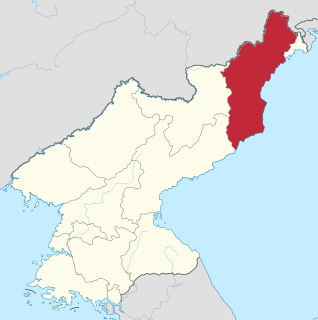Kilju Ch'ŏngnyŏn 길주청년 | ||||||||||||||||
|---|---|---|---|---|---|---|---|---|---|---|---|---|---|---|---|---|
| Korean name | ||||||||||||||||
| Hangul | 길주청년역 | |||||||||||||||
| Hanja | 吉 州 青 年 驛 | |||||||||||||||
| Revised Romanization | Giljucheongnyeon-yeok | |||||||||||||||
| McCune–Reischauer | Kiljuch'ŏngnyŏn-yŏk | |||||||||||||||
| General information | ||||||||||||||||
| Location | Kilju-ŭp, Kilju, North Hamgyŏng North Korea | |||||||||||||||
| Coordinates | 40°57′39″N129°19′24″E / 40.9609°N 129.3233°E Coordinates: 40°57′39″N129°19′24″E / 40.9609°N 129.3233°E | |||||||||||||||
| Owned by | Korean State Railway | |||||||||||||||
| History | ||||||||||||||||
| Opened | 1 November 1933 | |||||||||||||||
| Electrified | yes | |||||||||||||||
| Services | ||||||||||||||||
| ||||||||||||||||
Kilju Ch'ŏngnyŏn Station is a railway station in Kilju-ŭp, Kilju county, North Hamgyŏng province, North Korea. It is the junction point of the Paektusan Ch'ŏngnyŏn and P'yŏngra lines of the Korean State Railway. [1] [ page needed ]

Kilju, sometimes romanized as Kilchu, is a county in North Hamgyong province, North Korea. The county seat is Kilju Town.

North Hamgyong Province is the northernmost province of North Korea. The province was formed in 1896 from the northern half of the former Hamgyong Province.

North Korea, officially the Democratic People's Republic of Korea, is a country in East Asia constituting the northern part of the Korean Peninsula, with Pyongyang the capital and the largest city in the country. The name Korea is derived from Goguryeo which was one of the great powers in East Asia during its time, ruling most of the Korean Peninsula, Manchuria, parts of the Russian Far East and Inner Mongolia, under Gwanggaeto the Great. To the north and northwest, the country is bordered by China and by Russia along the Amnok and Tumen rivers; it is bordered to the south by South Korea, with the heavily fortified Korean Demilitarized Zone (DMZ) separating the two. Nevertheless, North Korea, like its southern counterpart, claims to be the legitimate government of the entire peninsula and adjacent islands.
Originally called Kilju Station (Chosŏn'gŭl: 길주역; Hanja: 吉州駅), the station, along with the rest of the Kilju-Hapsu section, was opened by the Government Railways of Chosen (朝鮮総督府鉄道) on 1 November 1933. [2] [ page needed ]

The Korean alphabet, known as Hangul, has been used to write the Korean language since its creation in the 15th century by King Sejong the Great. It may also be written as Hangeul following the standard Romanization.

Hanja is the Korean name for Chinese characters. More specifically, it refers to those Chinese characters borrowed from Chinese and incorporated into the Korean language with Korean pronunciation. Hanja-mal or Hanja-eo refers to words that can be written with Hanja, and hanmun refers to Classical Chinese writing, although "Hanja" is sometimes used loosely to encompass these other concepts. Because Hanja never underwent major reform, they are almost entirely identical to traditional Chinese and kyūjitai characters, though the stroke orders for some characters are slightly different. For example, the characters 教 and 研 are written as 敎 and 硏. Only a small number of Hanja characters are modified or unique to Korean. By contrast, many of the Chinese characters currently in use in Japan and Mainland China have been simplified, and contain fewer strokes than the corresponding Hanja characters.
Hapsu Station is a railway station in Paegam county, Ryanggang province, North Korea, on the Paektusan Ch'ŏngnyŏn Line of the Korean State Railway.
On 9 October 2006 an underground nuclear test was conducted at P'unggye-ri in Kilju County, causing the closure of the line for 3–4 months. [3]
P'unggye Station is a railway station in P'unggye-ri, Kilju county, North Hamgyŏng province, North Korea, on the Paektusan Ch'ŏngnyŏn Line of the Korean State Railway.
There is a pulp mill and a plywood factory in Kilju that receive raw logs via trains from the Paektusan Ch'ŏngnyŏn line. [4]
